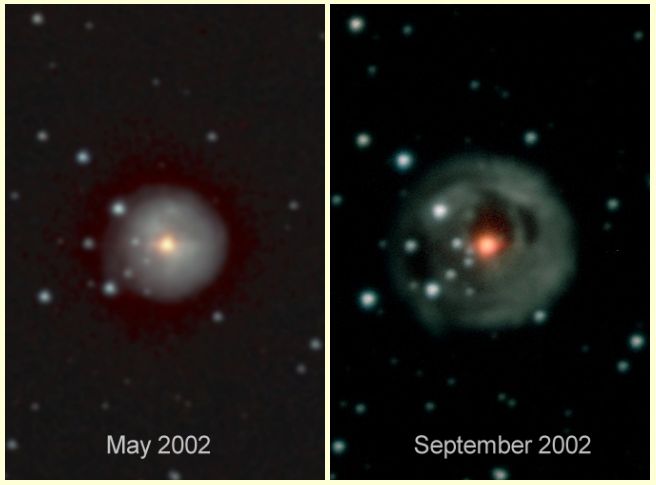
|
Credit & Copyright: Lisa Crause
(Univ. Cape Town),
Warrick Lawson
(Australian Defence Force Academy)
Explanation:
A leading candidate for the most mysterious star found in recent
times is variable star
V838 Monocerotis.
At a distance of about 8,000 light-years, V838
Mon was
discovered
to be in outburst in January of this year.
Initially thought to be a familiar type of
classical nova, astronomers
quickly realized that instead, V838 Mon may be a totally new addition to
the astronomical zoo.
Observations indicate
that the erupting star transformed itself
over a period of months from a small under-luminous star a little
hotter than the Sun, to a highly-luminous, cool supergiant star undergoing
rapid and complex brightness changes.
The transformation defies the conventional understanding of
stellar life cycles.
A most notable feature of V838 Mon is the "expanding" nebula which
now appears to surround it.
Seen above in two separate images from the
South African Astronomical
Observatory's 1 meter telescope,
the nebula is probably a light echo
from
shells of formerly unseen material lost by the star
during its previous evolution.
Light-years in diameter, the shells progressively reflect
the light from
V838 Mon's
outbursts, providing
an opportunity to look back at the history of this
remarkable star's behaviour.
|
January February March April May June July August September October November December |
| ||||||||||||||||||||||||||||||||||||||||||||||||
NASA Web Site Statements, Warnings, and Disclaimers
NASA Official: Jay Norris. Specific rights apply.
A service of: LHEA at NASA / GSFC
& Michigan Tech. U.
Based on Astronomy Picture
Of the Day
Publications with keywords: variable star - v838 mon
Publications with words: variable star - v838 mon
See also:
